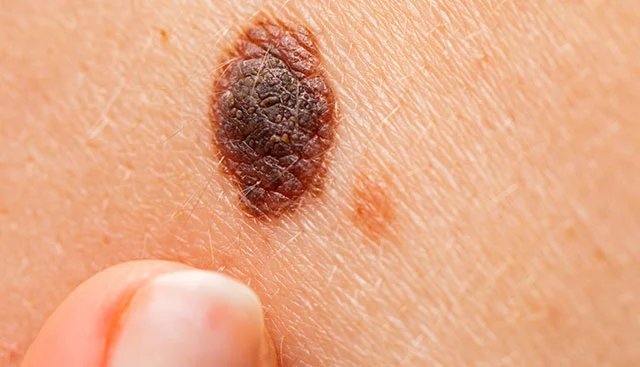Think you’ve spotted a suspicious mole? Maybe you notice a change in size, shape or colour. Or perhaps you have a spot that won’t heal. Skin cancer can look different from one person to the next. This makes it difficult to know when to be concerned.
While a comprehensive skin check is the best way to keep your skin safe, it’s also important to know the common skin cancer signs to watch for. This can help you to detect melanoma and other types of skin cancer early—when it’s most treatable. Here are the signs of skin cancer you should know.
Asymmetry
Most non-cancerous (benign) moles are symmetrical. Whereas melanoma tends to be asymmetrical. One half of the mole or lesion doesn’t not match the other.
Border Irregularities
Abnormal moles often have edges or borders that are irregular, ragged, notched or blurred. In some cases, the border may be hard to pinpoint because the colour fades towards the edges.
Change in Colour
Typically, harmless moles are even in colour. Most often they are pink, tan or brown. Melanoma can vary in colour and may contain up to five or six different shades. A melanoma may contain pink, red, blue, black, tan or grey.
Diameter or Different
Uncertain if you should be concerned about a mole? Consider whether it has changed in size. Or perhaps you have a mole that stands out and simply looks ‘different’ to other moles or spots on your body. This is sometimes referred to as the ‘ugly duckling sign’. If you do notice an ‘ugly duckling’ or odd-mole-out, get it checked out.
Evolving or Elevated
Non-cancerous moles tend to stay at the same shape, size and colour. Certain factors, such as sun exposure or hormones, may cause your moles to darken but in general they remain stable.
Firm
A firm mole or lesion is a feature of nodular melanoma. While non-cancerous spots can also feel firm, it’s worthwhile having it checked out.
Growing
Some types of melanoma, such as nodular melanoma, can quickly spread over days or weeks. Whereas, non-cancerous moles may bleed, if knocked, or become inflamed. Yet, they tend not to change in size.
Other Warning Signs of a Suspicious Mole
Some types of melanomas and other skin cancers may have different characteristics to those mentioned in the ABCDEFG rule above. Additional symptoms include:
- A new spot or mole
According to the Skin Cancer Foundation, melanoma most often (in 70-80% of cases) develops as a new spot or mole. However, don’t overlook the fact that up to 30% of melanomas appear in existing moles.
- Change in sensation
Cancerous moles may become itchy, painful or tender.
- Change in surface
A suspicious mole may become crusty or scaly. It may bleed or ooze. You may even notice a new bump or nodule within the existing mole.
- A sore that doesn’t heal
In most cases, a skin sore will heal within a few weeks. If you have a sore that doesn’t heal or heals and then becomes sore again, this could be a sign of basal or squamous cell skin cancer.
- A dark patch, stain or wart
Acral lentiginous melanoma can appear as a dark brown or black stain on the skin. It often develops on the feet and hands, including the nails. In some cases, it can appear as a thickened patch of skin and may be mistaken for a wart.
- Vision changes
Ocular melanoma is a type of melanoma that affects the eyes. It can cause blurry or distorted vision, dark patches on the whites of the eyes, and ‘floaters’ or flashes in the vision.
Why it Pays to Get a Regular Skin Cancer Screening
The ABCDEFG method of identifying a potential melanoma is useful, but it’s not fool-proof and should not be relied upon for certain. There’s also a wide range of skin cancer symptoms, many of which may go unnoticed.
A professional skin check includes a full head-to-toe examination. Your dermatologist or skin specialist knows what exactly to look for and where to look. They will also discuss your personal risk for skin cancer and provide advice on how best to keep your skin safe.

